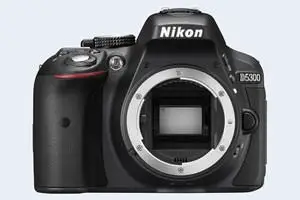Nikon D5100 vs D5300
The Nikon D5100 and the Nikon D5300 are two digital cameras that were revealed to the public, respectively, in April 2011 and October 2013. Both are DSLR (Digital Single Lens Reflex) cameras that are equipped with an APS-C sensor. The D5100 has a resolution of 16.1 megapixels, whereas the D5300 provides 24 MP.
Below is an overview of the main specs of the two cameras as a starting point for the comparison.

Check D5100 offers at
ebay.com

Check D5300 offers at
ebay.com
Going beyond this snapshot of core features and characteristics, what are the differences between the Nikon D5100 and the Nikon D5300? Which one should you buy? Read on to find out how these two cameras compare with respect to their body size, their imaging sensors, their shooting features, their input-output connections, and their reception by expert reviewers.
Body comparison
An illustration of the physical size and weight of the Nikon D5100 and the Nikon D5300 is provided in the side-by-side display below. The two cameras are presented according to their relative size. Three consecutive perspectives from the front, the top, and the back are available. All width, height and depth measures are rounded to the nearest millimeter.
The D5300 can be obtained in three different colors (black, grey, red), while the D5100 is only available in black.
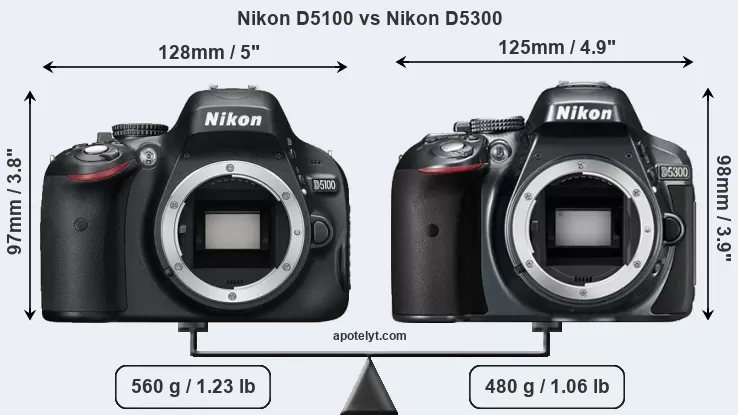

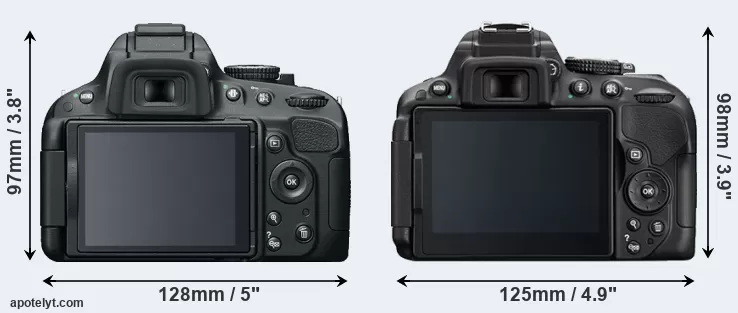
If the front view area (width x height) of the cameras is taken as an aggregate measure of their size, the Nikon D5300 is somewhat smaller (1 percent) than the Nikon D5100. Moreover, the D5300 is markedly lighter (14 percent) than the D5100. In this context, it is worth noting that neither the D5100 nor the D5300 are weather-sealed.
The above size and weight comparisons are to some extent incomplete since they do not consider the interchangeable lenses that both of these cameras require. In this particular case, both cameras feature the same lens mount, so that they can use the same lenses. You can compare the optics available in the Nikon Lens Catalog.
Concerning battery life, the D5100 gets 660 shots out of its Nikon EN-EL14 battery, while the D5300 can take 600 images on a single charge of its Nikon EN-EL14a power pack.
The adjacent table lists the principal physical characteristics of the two cameras alongside a wider set of alternatives. In case you want to display and compare another camera duo, you can use the CAM-parator app to select your camera combination among a large number of options.

| Camera Model |
Camera Width |
Camera Height |
Camera Depth |
Camera Weight |
Battery Life |
Weather Sealing |
Camera Launch |
Launch Price |
Street Price |
||
|---|---|---|---|---|---|---|---|---|---|---|---|
| 1. | Nikon D5100 | 128 mm | 97 mm | 79 mm | 560 g | 660 | n | Apr 2011 | US$ 749 | ebay.com | |
| 2. | Nikon D5300 | 125 mm | 98 mm | 76 mm | 480 g | 600 | n | Oct 2013 | US$ 799 | ebay.com | |
| 3. | Canon 550D | 129 mm | 98 mm | 62 mm | 530 g | 440 | n | Feb 2010 | US$ 699 | ebay.com | |
| 4. | Canon G1 X | 117 mm | 81 mm | 65 mm | 534 g | 250 | n | Jan 2012 | US$ 799 | ebay.com | |
| 5. | Nikon D3100 | 124 mm | 96 mm | 75 mm | 505 g | 550 | n | Aug 2010 | US$ 599 | ebay.com | |
| 6. | Nikon D3200 | 125 mm | 96 mm | 77 mm | 505 g | 540 | n | Apr 2012 | US$ 599 | ebay.com | |
| 7. | Nikon D3300 | 124 mm | 98 mm | 76 mm | 430 g | 700 | n | Jan 2014 | US$ 499 | ebay.com | |
| 8. | Nikon D5000 | 127 mm | 104 mm | 80 mm | 590 g | 510 | n | Apr 2009 | US$ 749 | ebay.com | |
| 9. | Nikon D5200 | 129 mm | 98 mm | 78 mm | 555 g | 500 | n | Nov 2012 | US$ 749 | ebay.com | |
| 10. | Nikon D5500 | 124 mm | 97 mm | 70 mm | 470 g | 820 | n | Jan 2015 | US$ 899 | ebay.com | |
| 11. | Nikon D5600 | 124 mm | 97 mm | 70 mm | 465 g | 970 | n | Nov 2016 | US$ 699 | ebay.com | |
| 12. | Nikon D7000 | 132 mm | 105 mm | 77 mm | 780 g | 1050 | Y | Sep 2010 | US$ 1 499 | ebay.com | |
| Note: Measurements and pricing do not include easily detachable parts, such as add-on or interchangeable lenses or optional viewfinders. | |||||||||||
Any camera decision will obviously take relative prices into account. The listed launch prices provide an indication of the market segment that the manufacturer of the cameras have been targeting. The D5100 was somewhat cheaper (by 6 percent) than the D5300 at launch, but both cameras fall into the same price category. Usually, retail prices stay at first close to the launch price, but after several months, discounts become available. Later in the product cycle and, in particular, when the replacement model is about to appear, further discounting and stock clearance sales often push the camera price considerably down. Then, after the new model is out, very good deals can frequently be found on the pre-owned market.
Sensor comparison
The size of the imaging sensor is a crucial determinant of image quality. A large sensor will tend to have larger individual pixels that provide better low-light sensitivity, wider dynamic range, and richer color-depth than smaller pixel-units in a sensor of the same technological generation. Furthermore, a large sensor camera will give the photographer more possibilities to use shallow depth-of-field in order to isolate a subject from the background. On the downside, larger sensors tend to be more expensive and lead to bigger and heavier cameras and lenses.
Both cameras under consideration feature an APS-C sensor, but their sensors differ slightly in size. The sensor area in the D5300 is 1 percent smaller. They nevertheless have the same format factor of 1.5. Both cameras have a native aspect ratio (sensor width to sensor height) of 3:2.
Technology-wise, the D5300 uses a more advanced image processing engine (EXPEED 4) than the D5100 (EXPEED 2), with benefits for noise reduction, color accuracy, and processing speed.
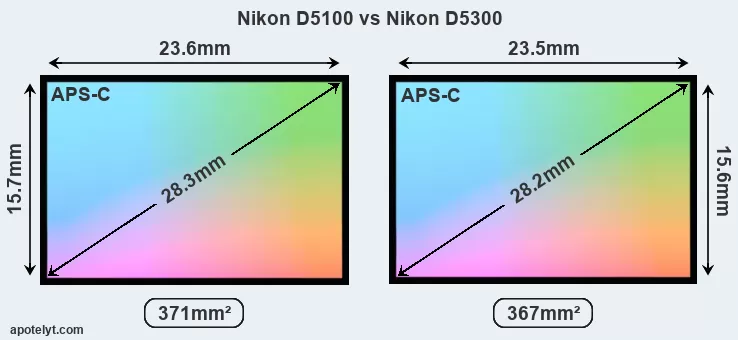
Despite having a slightly smaller sensor, the D5300 offers a higher resolution of 24 megapixels, compared with 16.1 MP of the D5100. This megapixels advantage comes at the cost of a higher pixel density and a smaller size of the individual pixel (with a pixel pitch of 3.91μm versus 4.80μm for the D5100). However, it should be noted that the D5300 is much more recent (by 2 years and 6 months) than the D5100, and its sensor will have benefitted from technological advances during this time that make it possible to gather light more efficiently. Coming back to sensor resolution, it should be mentioned that the D5300 has no anti-alias filter installed, so that it can capture all the detail its sensor resolves.
The resolution advantage of the Nikon D5300 implies greater flexibility for cropping images or the possibility to print larger pictures. The maximum print size of the D5300 for good quality output (200 dots per inch) amounts to 30 x 20 inches or 76.2 x 50.8 cm, for very good quality (250 dpi) 24 x 16 inches or 61 x 40.6 cm, and for excellent quality (300 dpi) 20 x 13.3 inches or 50.8 x 33.9 cm. The corresponding values for the Nikon D5100 are 24.6 x 16.3 inches or 62.6 x 41.5 cm for good quality, 19.7 x 13.1 inches or 50.1 x 33.2 cm for very good quality, and 16.4 x 10.9 inches or 41.7 x 27.6 cm for excellent quality prints.
The Nikon D5100 has a native sensitivity range from ISO 100 to ISO 6400, which can be extended to ISO 100-25600. The corresponding ISO settings for the Nikon D5300 are ISO 100 to ISO 12800, with the possibility to increase the ISO range to 100-25600.
Technology-wise, both cameras are equipped with CMOS (Complementary Metal–Oxide–Semiconductor) sensors. Both cameras use a Bayer filter for capturing RGB colors on a square grid of photosensors. This arrangement is found in most digital cameras.
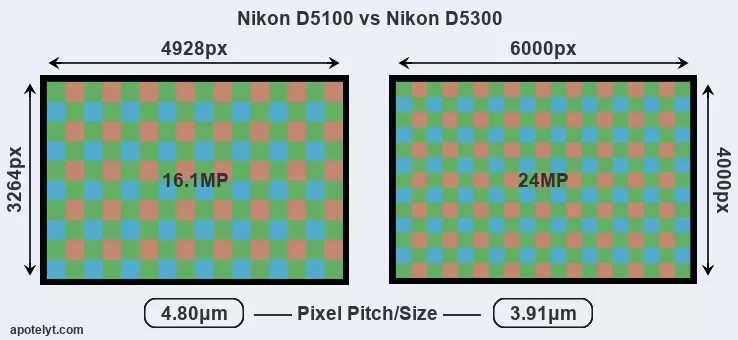
Consistent information on actual sensor performance is available from DXO Mark for many cameras. This service is based on lab testing and assigns an overall score to each camera sensor, as well as ratings for dynamic range ("DXO Landscape"), color depth ("DXO Portrait"), and low-light sensitivity ("DXO Sports"). The Overall DXO ratings for the two cameras under consideration are close, suggesting that they provide similar imaging performance. The adjacent table reports on the physical sensor characteristics and the outcomes of the DXO sensor quality tests for a sample of comparator-cameras.

| Camera Model |
Sensor Class |
Resolution (MP) |
Horiz. Pixels |
Vert. Pixels |
Video Format |
DXO Portrait |
DXO Landscape |
DXO Sports |
DXO Overall |
||
|---|---|---|---|---|---|---|---|---|---|---|---|
| 1. | Nikon D5100 | APS-C | 16.1 | 4928 | 3264 | 1080/30p | 23.5 | 13.6 | 1183 | 80 | |
| 2. | Nikon D5300 | APS-C | 24.0 | 6000 | 4000 | 1080/60p | 24.0 | 13.9 | 1338 | 83 | |
| 3. | Canon 550D | APS-C | 17.9 | 5184 | 3456 | 1080/30p | 22.1 | 11.5 | 784 | 66 | |
| 4. | Canon G1 X | 1.5-inch | 14.2 | 4352 | 3264 | 1080/24p | 21.7 | 10.8 | 644 | 60 | |
| 5. | Nikon D3100 | APS-C | 14.2 | 4608 | 3072 | 1080/24p | 22.5 | 11.3 | 919 | 67 | |
| 6. | Nikon D3200 | APS-C | 24.1 | 6016 | 4000 | 1080/30p | 24.1 | 13.2 | 1131 | 81 | |
| 7. | Nikon D3300 | APS-C | 24.0 | 6000 | 4000 | 1080/60p | 24.3 | 12.8 | 1385 | 82 | |
| 8. | Nikon D5000 | APS-C | 12.2 | 4288 | 2848 | 720/24p | 22.7 | 12.5 | 868 | 72 | |
| 9. | Nikon D5200 | APS-C | 24.0 | 6000 | 4000 | 1080/60i | 24.2 | 13.9 | 1284 | 84 | |
| 10. | Nikon D5500 | APS-C | 24.0 | 6000 | 4000 | 1080/60p | 24.1 | 14.0 | 1438 | 84 | |
| 11. | Nikon D5600 | APS-C | 24.0 | 6000 | 4000 | 1080/60p | 24.1 | 14.0 | 1306 | 84 | |
| 12. | Nikon D7000 | APS-C | 16.1 | 4928 | 3264 | 1080/24p | 23.5 | 13.9 | 1167 | 80 |
Many modern cameras cannot only take still pictures, but also record videos. Both cameras under consideration are equipped with sensors that have a sufficiently high read-out speed for moving images, but the D5300 provides a faster frame rate than the D5100. It can shoot movie footage at 1080/60p, while the D5100 is limited to 1080/30p.
Feature comparison
Apart from body and sensor, cameras can and do differ across a range of features. The D5100 and the D5300 are similar in the sense that both have an optical viewfinder. The latter is useful for getting a clear image for framing even in brightly lit environments. The viewfinders of both cameras offer the same field of view (95%), but the viewfinder of the D5300 has a higher magnification than the one of the D5100 (0.57x vs 0.51x), so that the size of the image transmitted appears closer to the size seen with the naked human eye. The following table reports on some other key feature differences and similarities of the Nikon D5100, the Nikon D5300, and comparable cameras.

| Camera Model |
Viewfinder (Type or 000 dots) |
Control Panel (yes/no) |
LCD Specifications (inch/000 dots) |
LCD Attach- ment |
Touch Screen (yes/no) |
Max Shutter Speed * |
Max Shutter Flaps * |
Built-in Flash (yes/no) |
Built-in Image Stab |
||
|---|---|---|---|---|---|---|---|---|---|---|---|
| 1. | Nikon D5100 | optical | n | 3.0 / 921 | swivel | n | 1/4000s | 4.0/s | Y | n | |
| 2. | Nikon D5300 | optical | n | 3.2 / 1037 | swivel | n | 1/4000s | 5.0/s | Y | n | |
| 3. | Canon 550D | optical | n | 3.0 / 1040 | fixed | n | 1/4000s | 3.7/s | Y | n | |
| 4. | Canon G1 X | optical | n | 3.0 / 922 | swivel | n | 1/4000s | 1.9/s | Y | Y | |
| 5. | Nikon D3100 | optical | n | 3.0 / 230 | fixed | n | 1/4000s | 3.0/s | Y | n | |
| 6. | Nikon D3200 | optical | n | 3.0 / 921 | fixed | n | 1/4000s | 4.0/s | Y | n | |
| 7. | Nikon D3300 | optical | n | 3.0 / 921 | fixed | n | 1/4000s | 5.0/s | Y | n | |
| 8. | Nikon D5000 | optical | n | 2.7 / 230 | full-flex | n | 1/4000s | 4.0/s | Y | n | |
| 9. | Nikon D5200 | optical | n | 3.0 / 921 | swivel | n | 1/4000s | 5.0/s | Y | n | |
| 10. | Nikon D5500 | optical | n | 3.2 / 1037 | swivel | Y | 1/4000s | 5.0/s | Y | n | |
| 11. | Nikon D5600 | optical | n | 3.2 / 1037 | swivel | Y | 1/4000s | 5.0/s | Y | n | |
| 12. | Nikon D7000 | optical | Y | 3.0 / 921 | fixed | n | 1/8000s | 6.0/s | Y | n | |
| Note: *) Information refers to the mechanical shutter, unless the camera only has an electronic one. | |||||||||||
The Nikon D5100 and the Nikon D5300 both have an intervalometer built-in. This enables the photographer to capture time lapse sequences, such as flower blooming, a sunset or moon rise, without purchasing an external camera trigger and related software.
Concerning the storage of imaging data, both the D5100 and the D5300 write their files to SDXC cards. Both cameras can use UHS-I cards, which provide for Ultra High Speed data transfer of up to 104 MB/s.
Connectivity comparison
For some imaging applications, the extent to which a camera can communicate with its environment can be an important aspect in the camera decision process. The table below provides an overview of the connectivity of the Nikon D5100 and Nikon D5300 and, in particular, the interfaces the cameras (and selected comparators) provide for accessory control and data transfer.

| Camera Model |
Hotshoe Port |
Internal Mic / Speaker |
Microphone Port |
Headphone Port |
HDMI Port |
USB Port |
WiFi Support |
NFC Support |
Bluetooth Support |
||
|---|---|---|---|---|---|---|---|---|---|---|---|
| 1. | Nikon D5100 | Y | mono / mono | Y | - | mini | 2.0 | - | - | - | |
| 2. | Nikon D5300 | Y | stereo / mono | Y | - | mini | 2.0 | Y | - | - | |
| 3. | Canon 550D | Y | stereo / - | Y | - | mini | 2.0 | - | - | - | |
| 4. | Canon G1 X | Y | stereo / mono | - | - | mini | 2.0 | - | - | - | |
| 5. | Nikon D3100 | Y | mono / mono | - | - | mini | 2.0 | - | - | - | |
| 6. | Nikon D3200 | Y | mono / mono | Y | - | mini | 2.0 | - | - | - | |
| 7. | Nikon D3300 | Y | mono / mono | Y | - | mini | 2.0 | - | - | - | |
| 8. | Nikon D5000 | Y | mono / mono | - | - | mini | 2.0 | - | - | - | |
| 9. | Nikon D5200 | Y | stereo / mono | Y | - | mini | 2.0 | - | - | - | |
| 10. | Nikon D5500 | Y | stereo / mono | Y | - | mini | 2.0 | Y | - | - | |
| 11. | Nikon D5600 | Y | stereo / mono | Y | - | mini | 2.0 | Y | Y | Y | |
| 12. | Nikon D7000 | Y | mono / mono | Y | - | mini | 2.0 | - | - | - |
It is notable that the D5300 offers wifi support, which can be a very convenient means to transfer image data to an off-camera location. In contrast, the D5100 does not provide wifi capability.
Travel and landscape photographers will find it useful that the D5300 has an internal geolocalization sensor and can record GPS coordinates in its EXIF data.
Both the D5100 and the D5300 have been discontinued, but can regularly be found used on ebay. The D5100 was replaced by the Nikon D5200, while the D5300 was followed by the Nikon D5500. Further information on the features and operation of the D5100 and D5300 can be found, respectively, in the Nikon D5100 Manual (free pdf) or the online Nikon D5300 Manual.
Review summary
So how do things add up? Is the Nikon D5100 better than the Nikon D5300 or vice versa? Below is a summary of the relative strengths of each of the two contestants.
Arguments in favor of the Nikon D5100:
- Better moiré control: Has an anti-alias filter to avoid artificial patterns to appear in images.
- More heavily discounted: Has been available for much longer (launched in April 2011).
Reasons to prefer the Nikon D5300:
- More detail: Has more megapixels (24 vs 16.1MP), which boosts linear resolution by 22%.
- Maximized detail: Lacks an anti-alias filter to exploit the sensor's full resolution potential.
- Better jpgs: Has a more modern image processing engine (EXPEED 4 vs EXPEED 2).
- Better video: Provides higher movie framerates (1080/60p versus 1080/30p).
- Larger viewfinder image: Features a viewfinder with a higher magnification (0.57x vs 0.51x).
- Larger screen: Has a bigger rear LCD (3.2" vs 3.0") for image review and settings control.
- More detailed LCD: Has a higher resolution rear screen (1037k vs 921k dots).
- Faster burst: Shoots at higher frequency (5 vs 4 flaps/sec) to capture the decisive moment.
- Less heavy: Has a lower weight (by 80g or 14 percent) and is thus easier to take along.
- Easier geotagging: Features an internal GPS sensor to log localization data.
- Easier file upload: Has wifi built in for automatic backup or image transfer to the web.
- More modern: Reflects 2 years and 6 months of technical progress since the D5100 launch.
If the number of relative strengths (bullet points above) is taken as a guide, the D5300 is the clear winner of the contest (12 : 2 points). However, the relative importance of the various individual camera aspects will vary according to personal preferences and needs, so that you might like to apply corresponding weights to the particular features before making a decision on a new camera. A professional wildlife photographer will view the differences between cameras in a way that diverges from the perspective of a family photog, and a person interested in architecture has distinct needs from a sports shooter. Hence, the decision which camera is best and worth buying is often a very personal one.
How about other alternatives? Do the specifications of the Nikon D5100 and the Nikon D5300 place the cameras among the top in their class? Find out in the latest Best DSLR Camera listing whether the two cameras rank among the cream of the crop.
In any case, while the comparison of technical specifications can provide a useful overview of the capabilities of different cameras, it says little about, for example, the shooting experience and imaging performance of the D5100 and the D5300 in practical situations. At times, user reviews, such as those published at amazon, address these issues in a useful manner, but such feedback is on many occasions incomplete, inconsistent, and unreliable.
Expert reviews
This is why hands-on reviews by experts are important. The table below provides a synthesis of the camera assessments of some of the best known photo-gear review sites (amateurphotographer [AP], cameralabs [CL], digitalcameraworld [DCW], dpreview [DPR], ephotozine [EPZ], photographyblog [PB]). As can be seen, the professional reviewers agree in many cases on the quality of different cameras, but sometimes their assessments diverge, reinforcing the earlier point that a camera decision is often a very personal choice.

| Camera Model |
AP score |
CL score |
DCW score |
DPR score |
EPZ score |
PB score |
Camera Launch |
Launch Price |
Street Price |
||
|---|---|---|---|---|---|---|---|---|---|---|---|
| 1. | Nikon D5100 | 5/5 | + + | .. | 76/100 | 4.5/5 | 4.5/5 | Apr 2011 | US$ 749 | ebay.com | |
| 2. | Nikon D5300 | 4/5 | + + | .. | 79/100 | 4.5/5 | 4.5/5 | Oct 2013 | US$ 799 | ebay.com | |
| 3. | Canon 550D | .. | + + | .. | 77/100 | 4/5 | 4.5/5 | Feb 2010 | US$ 699 | ebay.com | |
| 4. | Canon G1 X | 5/5 | + | .. | 76/100 | 4/5 | 4.5/5 | Jan 2012 | US$ 799 | ebay.com | |
| 5. | Nikon D3100 | 5/5 | + + | .. | 72/100 | 4.5/5 | 4.5/5 | Aug 2010 | US$ 599 | ebay.com | |
| 6. | Nikon D3200 | 5/5 | + + | .. | 73/100 | 4.5/5 | 4.5/5 | Apr 2012 | US$ 599 | ebay.com | |
| 7. | Nikon D3300 | 3/5 | + | .. | 77/100 | 4.5/5 | 4.5/5 | Jan 2014 | US$ 499 | ebay.com | |
| 8. | Nikon D5000 | .. | + + | .. | 75/100 | 4/5 | 4.5/5 | Apr 2009 | US$ 749 | ebay.com | |
| 9. | Nikon D5200 | 4/5 | + + | .. | 79/100 | 4.5/5 | 4.5/5 | Nov 2012 | US$ 749 | ebay.com | |
| 10. | Nikon D5500 | 5/5 | + | .. | 79/100 | 4.5/5 | 4.5/5 | Jan 2015 | US$ 899 | ebay.com | |
| 11. | Nikon D5600 | 4/5 | .. | 4/5 | 79/100 | 4.5/5 | 4/5 | Nov 2016 | US$ 699 | ebay.com | |
| 12. | Nikon D7000 | 4/5 | .. | .. | 80/100 | 4.5/5 | 4.5/5 | Sep 2010 | US$ 1 499 | ebay.com | |
| Note: (+ +) highly recommended; (+) recommended; (o) reviewed; (..) not available. | |||||||||||
The above review scores should be interpreted with care, though. The ratings were established in reference to similarly priced cameras that were available in the market at the time of the review. A score, therefore, has to be seen in close connection to the price and market introduction time of the camera, and comparing ratings of very distinct cameras or ones that are far apart in terms of their release date have little meaning. It should also be noted that some of the review sites have over time altered the way they render their verdicts.

Check D5100 offers at
ebay.com

Check D5300 offers at
ebay.com
Other camera comparisons
Did this review help to inform your camera decision process? In case you would like to check on the differences and similarities of other camera models, just make your choice using the following search menu. There is also a set of direct links to comparison reviews that other users of the CAM-parator app explored.
- Canon 10D vs Nikon D5100
- Canon R50 vs Nikon D5300
- Canon SX510 vs Nikon D5100
- Canon SX730 vs Nikon D5300
- Fujifilm X-T2 vs Nikon D5100
- Fujifilm X100F vs Nikon D5300
- Nikon D3300 vs Nikon D5100
- Nikon D5100 vs Olympus E-30
- Nikon D5100 vs Panasonic FZ100
- Nikon D5300 vs Nikon D5500
- Nikon D5300 vs Nikon Z5
- Nikon D5300 vs Olympus E-500
Specifications: Nikon D5100 vs Nikon D5300
Below is a side-by-side comparison of the specs of the two cameras to facilitate a quick review of their differences and common features.
| Camera Model | Nikon D5100 | Nikon D5300 |
|---|---|---|
| Camera Type | Digital single lens reflex | Digital single lens reflex |
| Camera Lens | Nikon F mount lenses | Nikon F mount lenses |
| Launch Date | April 2011 | October 2013 |
| Launch Price | USD 749 | USD 799 |
| Sensor Specs | Nikon D5100 | Nikon D5300 |
| Sensor Technology | CMOS | CMOS |
| Sensor Format | APS-C Sensor | APS-C Sensor |
| Sensor Size | 23.6 x 15.7 mm | 23.5 x 15.6 mm |
| Sensor Area | 370.52 mm2 | 366.6 mm2 |
| Sensor Diagonal | 28.3 mm | 28.2 mm |
| Crop Factor | 1.5x | 1.5x |
| Sensor Resolution | 16.1 Megapixels | 24 Megapixels |
| Image Resolution | 4928 x 3264 pixels | 6000 x 4000 pixels |
| Pixel Pitch | 4.80 μm | 3.91 μm |
| Pixel Density | 4.34 MP/cm2 | 6.55 MP/cm2 |
| Moiré control | Anti-Alias filter | no AA filter |
| Movie Capability | 1080/30p Video | 1080/60p Video |
| ISO Setting | 100 - 6,400 ISO | 100 - 12,800 ISO |
| ISO Boost | 100 - 25,600 ISO | 100 - 25,600 ISO |
| Image Processor | EXPEED 2 | EXPEED 4 |
| DXO Sensor Quality (score) | 80 | 83 |
| DXO Color Depth (bits) | 23.5 | 24.0 |
| DXO Dynamic Range (EV) | 13.6 | 13.9 |
| DXO Low Light (ISO) | 1183 | 1338 |
| Screen Specs | Nikon D5100 | Nikon D5300 |
| Viewfinder Type | Optical viewfinder | Optical viewfinder |
| Viewfinder Field of View | 95% | 95% |
| Viewfinder Magnification | 0.51x | 0.57x |
| LCD Framing | Live View | Live View |
| Rear LCD Size | 3.0inch | 3.2inch |
| LCD Resolution | 921k dots | 1037k dots |
| LCD Attachment | Swivel screen | Swivel screen |
| Shooting Specs | Nikon D5100 | Nikon D5300 |
| Focus System | Phase-detect AF | Phase-detect AF |
| Continuous Shooting | 4 shutter flaps/s | 5 shutter flaps/s |
| Shutter Life Expectancy | 100 000 actuations | 100 000 actuations |
| Time-Lapse Photography | Intervalometer built-in | Intervalometer built-in |
| Fill Flash | Built-in Flash | Built-in Flash |
| Storage Medium | SDXC cards | SDXC cards |
| Single or Dual Card Slots | Single card slot | Single card slot |
| UHS card support | UHS-I | UHS-I |
| Connectivity Specs | Nikon D5100 | Nikon D5300 |
| External Flash | Hotshoe | Hotshoe |
| USB Connector | USB 2.0 | USB 2.0 |
| HDMI Port | mini HDMI | mini HDMI |
| Microphone Port | External MIC port | External MIC port |
| Wifi Support | no Wifi | Wifi built-in |
| Geotagging | no internal GPS | GPS built-in |
| Body Specs | Nikon D5100 | Nikon D5300 |
| Battery Type | Nikon EN-EL14 | Nikon EN-EL14a |
| Battery Life (CIPA) | 660 shots per charge | 600 shots per charge |
| Body Dimensions |
128 x 97 x 79 mm (5.0 x 3.8 x 3.1 in) |
125 x 98 x 76 mm (4.9 x 3.9 x 3.0 in) |
| Camera Weight | 560 g (19.8 oz) | 480 g (16.9 oz) |

Check D5100 offers at
ebay.com

Check D5300 offers at
ebay.com
Did you notice an error on this page? If so, please get in touch, so that we can correct the information.

